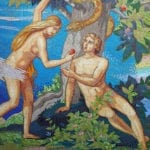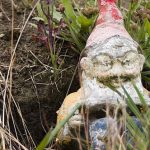 Movies and TV
Movies and TV  Movies and TV
Movies and TV  Health
Health 10 Miraculous Advances Toward Curing Incurable Diseases
 Miscellaneous
Miscellaneous 10 Undeniable Signs That People’s Views of Mushrooms Are Changing
 Animals
Animals 10 Strange Attempts to Smuggle Animals
 Travel
Travel 10 Natural Rock Formations That Will Make You Do a Double Take
 Movies and TV
Movies and TV 10 Actors Hidden in Your Favorite Movies
 Our World
Our World 10 Science Facts That Will Change How You Look at the World
 Pop Culture
Pop Culture 10 Incredible Female Comic Book Artists
 Crime
Crime 10 Terrifying Serial Killers from Centuries Ago
 Technology
Technology 10 Hilariously Over-Engineered Solutions to Simple Problems
 Movies and TV
Movies and TV 10 Movie Adaptions That Brought Popular Songs to Life
 Health
Health 10 Miraculous Advances Toward Curing Incurable Diseases
 Miscellaneous
Miscellaneous 10 Undeniable Signs That People’s Views of Mushrooms Are Changing
Who's Behind Listverse?

Jamie Frater
Head Editor
Jamie founded Listverse due to an insatiable desire to share fascinating, obscure, and bizarre facts. He has been a guest speaker on numerous national radio and television stations and is a five time published author.
More About Us Animals
Animals 10 Strange Attempts to Smuggle Animals
 Travel
Travel 10 Natural Rock Formations That Will Make You Do a Double Take
 Movies and TV
Movies and TV 10 Actors Hidden in Your Favorite Movies
 Our World
Our World 10 Science Facts That Will Change How You Look at the World
 Pop Culture
Pop Culture 10 Incredible Female Comic Book Artists
 Crime
Crime 10 Terrifying Serial Killers from Centuries Ago
 Technology
Technology 10 Hilariously Over-Engineered Solutions to Simple Problems
10 Surreal Facts about Italy’s Garden of Monsters
For most of us, the word “garden” elicits an image of a blissful nature scene that enchants the senses with a wide array of flowers and plants, a beautiful fountain or statue, and a serene atmosphere. It does not typically call to mind an assortment of grotesque and frightening monsters, but that is exactly what one man visualized for his.
To this day, the 16th-century monster-filled garden, located just 42 miles (67 kilometers) northwest of Rome in the quiet Italian town of Bomarzo, remains the only of its kind. Historians are still trying to figure out what the creator was trying to communicate with its terrifying creations. Though he never confessed an underlying message, he may have left some breadcrumbs for visitors to find.
An inscription carved into a stone bench in the garden reads: “You that are wandering through the world, willing to see high and splendid marvels, do come here where there are horrible faces, elephants, lions, bears, ogres and dragons.” Experience the mystery for yourself with these 10 surreal facts about Italy’s Garden of Monsters.
Related: 10 Weird Things We Have Found Inside Statues
10 A Garden of Many Names

The Garden of Monsters, also known as Sacro Bosco (Sacred Woods), Parco dei Mostri (Park of Monsters), or sometimes Bosco dei Mostri (Forest of Monsters), was created by the Duke of Bomarzo, Pier Francesco (“Vicino”) Orsini. Orsini (1523–1585) belonged to a minor branch of a powerful Roman family. He was known as an Italian condottiere, a patron of the arts, and one of the literati.
However, Orsini’s privileged life suddenly turned dark when he was a general in the pope’s army during the Italian Wars and witnessed the death of his good friend and commander, Orazio Farnese. In the same battle, he was taken as a prisoner of war and held for ransom in Germany for several years. Shortly after returning home to Bomarzo, Orsini lost his beloved wife, Giulia.
Overcome with grief, he distanced himself from religion and converted to Epicureanism, “a philosophy devoted to simple pleasures as defined by the absence of pain and the advocacy of a moderate life.” Orsini sought comfort in the company of artists, writers, and other creative people and spent much of his time in the garden, which he often referred to as his “Villa of Wonders.”[1]
9 Defied the Typical Renaissance Garden Design
Many beautiful gardens created during the Renaissance can be found across the Italian peninsula. However, the Garden of Monsters was unlike any of these. All the trees and shrubbery were left undisturbed, while “unusual and grotesque creatures” were placed randomly throughout the grounds. The sculptures embody a rough “mannerist” style, a 16th-century version of surrealism. Three theories attempt to explain Orsini’s intentions behind the unique design:
The first is based on Orsini’s interest in classical literature. It suggests that the garden was inspired by Arcadia (or Utopia), a poetic term associated with a place where art and nature are combined. The second theory was that the design was meant to counter that of his friend, Cristoforo Madruzzo, whose garden in Soriano di Cimino was representative of “all that was good and light in the world.”
Orsini’s representation of the world’s “dark and discordant elements” could easily be considered a fitting contrast. The third and most popular theory is that the monster-filled garden is a reflection of his personal demons.[2]
8 The Garden Was Designed by a Famous Artist
Orsini hired the highly respected artist, papal architect, and Renaissance garden designer Pirro Ligorio to design more than 30 statues and sculptures in his garden. Ligorio had previously completed the Cathedral of Saint Peter in Rome after the death of Michelangelo and the Villa d’Este in Tivoli. Though a distinctly different style than the previous works, Ligorio likely enjoyed the job as he shared Orsini’s interest in the grotesque.
In his study, “Master Drawings,” art historian John H. Gere described some of Ligorio’s drawings as depicting figures with “monstrous hands, clumsily attached to the arms by grotesquely malformed wrists” and other exaggerations that stray far beyond the realms of classicism.
Reportedly annoyed at how Renaissance artists portrayed monstrous mythical creatures (such as sirens, giants, and dragons) as “too human,” Ligorio believed they should appear much more grossly exaggerated. It was an opinion that Orsini shared. Ligorio brought their vision to life in the Garden of Monsters. The project took over 30 years to complete.[3]
7 A Mortuary Temple for His Late Wife
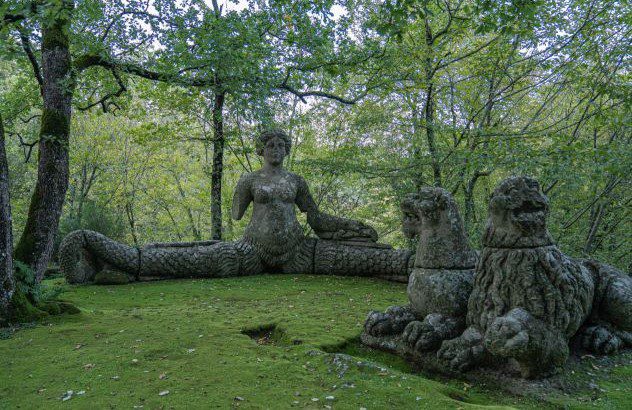
Many have speculated that Orsini dedicated the garden to his first wife, Giulia Farnese, a relative of the commander and friend that he fought beside and lost in the war. It is one of the theories Lynette Bosch researched for her study in Garden History. Scouring through letters, publications, and any other documents she could find, Bosch was eager to determine how long Giulia lived after Orsini was released as a prisoner of war and before the creation of the garden.
Bosch found that the first monsters were created by 1552, while Giulia was mentioned as alive in a 1556 publication from one of Orsini’s contemporaries. Some letters to and from Orsini led Bosch to believe that he had a memorial sculpture built in her memory, the octagonal Temple of Eternity, located at the highest point in the Garden of Monsters.[4]
6 “Elefante” the War Elephant
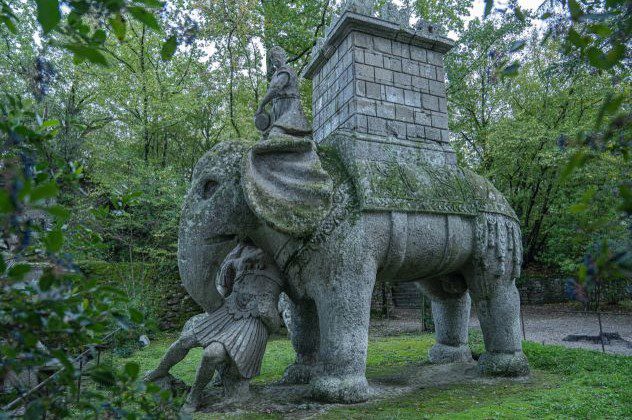
Giulia’s mortuary temple was one of several sculptures within the Garden of Monsters thought to be more than meets the eye. Another is “Elefante,” also known as “Hannibal’s War Elephant.” Elefante portrays the tragic events from Orsini’s military career, symbolizing the Battle of Hesdin, where he witnessed the loss of his good friend and commander, Farnese, before being taken as a prisoner of war.
The large stone animal carries a corpse in its trunk that appears to be dressed in a Roman military uniform, representing the painful loss of his friend. Orsini’s capture and imprisonment are also depicted in the statue by the tower on the elephant’s back. Bosch’s study suggests that the additional imagery on the sculpture symbolizes a link between the threat of opposing forces.[5]
5 “Gigante” the Giant
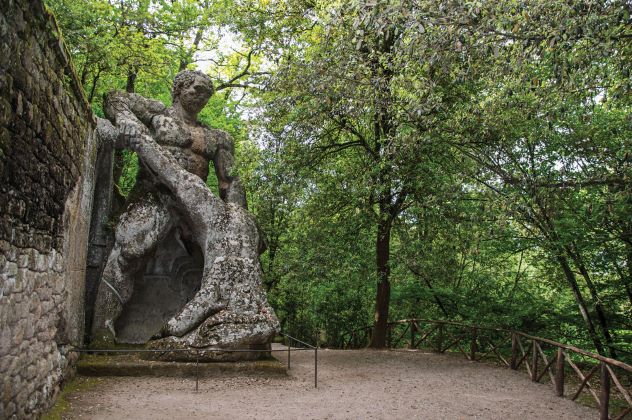
One of the last sculptures built in the Garden of Monsters was “Gigante” the giant, also known as “Fighting Giants.” The sculpture, which depicts a giant tearing another giant in half, was inspired by a poem called “Orlando Furioso” that paralleled an event in Orsini’s life. According to Colombia University, the poem tells of a love story that turned bitter when Knight Orlando learned that his beloved lost her virginity to a foot soldier ranked beneath him.
Driven mad with rage, Orlando stripped off his armor and clothes and went on a rampage, attacking and killing any plant, animal, or human he came across with nothing but his bare hands. In a similar tale, when Orsini returned home from his trials at war, he found that his mistress had left him. The sculpture depicts the wrenching pain that overtook him when he learned she had run off with another man.[6]
4 The Duality of “Orcus”
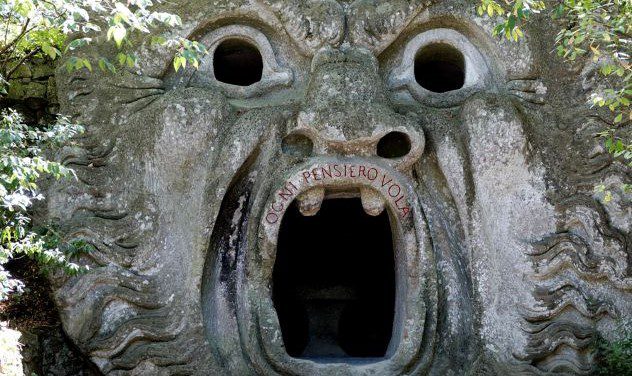
One of the most recognizable sculptures in Orsini’s Garden of Monsters is the disembodied head of an ogre known as “Orcus.” The head appears frozen in the middle of a scream, its mouth perpetually open [LINK 3]. More than just a sculpture, Orcus was also designed as a place to eat, making it seem as though you are eating and being eaten at the same time. If one dares to venture inside the mouth, they will find a picnic table formed by Hell’s tongue and seating space for a small dinner party.
There is also an inscription written above the mouth of Orcus that may sound familiar to visitors. It is said that the gates of Hell feature the inscription: “abandon all hope those who enter here.” Similarly, the words written over Orcus’s mouth read: “all reason departs,” possibly suggesting the abandonment of all reason before entering. The detail likely inspired the nickname: “Mouth of Hell.”[7]
3 Its Purpose May Be Found in the Inscriptions
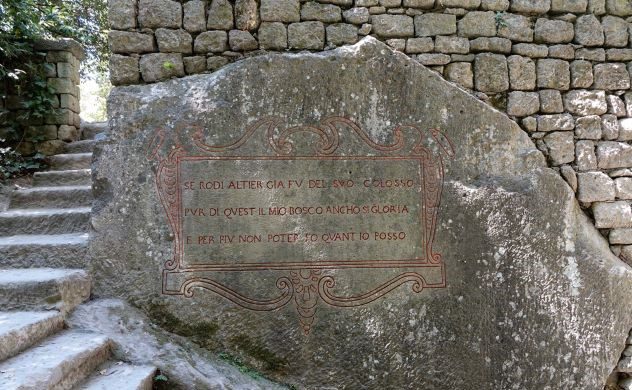
The inscription on the Orcus statue is one of many found within the garden. All employ equally cryptic messages that have intrigued visitors for decades. For example, the words: “And all other marvels prized before by the world yield to the Sacred Wood that resembles only itself and nothing else.” Melinda Schlitt, art history and humanities professor at Dickinson College, explains it as urging visitors to avoid comparing the garden to other “marvels” of the world and appreciate it for what it is.
Another inscription reads: “Thou who enter this garden, be very attentive and tell me then if these marvels have been created to deceive visitors, or for the sake of art.” Yet another reads: “Just to set the heart free.” Many have wondered if one of the inscriptions was meant to reveal Orsini’s true purpose for creating the Garden of Monsters, but there is no way to know for sure.[8]
2 Salvador Dali Brought the Garden to the Public Eye
In 1938, several centuries after Orsini’s death, well-known surrealist painter and filmmaker Salvador Dali discovered the Garden of Monsters. The grounds were wildly overgrown and long-forgotten, but Dali found inspiration in the grotesque works in stone. He created a short film based on the garden, called “In the World of the Surreal: Salvador Dali in the Garden of Monsters,” which aired on November 10, 1948.
In Studies in the History of Gardens & Designed Landscapes, Thalia Allington-Wood recounts watching Dali clambering on the statues as an orchestra played in the background, holding what looked like a conductors stick on the top of Elephante and crouching by a candle in Orcus’s mouth. Other clips from the film presented the garden “solely through the workings of the Surrealist artist’s mind.”
Dali also referenced the monsters from the garden in his 1964 painting The Temptation of Saint Anthony, which was one of his most famous artworks. Dali’s film and painting sparked public interest in Orsini’s garden. Soon it was being discussed in articles, essays, and novels, and even inspired an opera in 1967 called Bomarzo.[9]
1 The Garden of Monsters is Now a Tourist Destination
What was once a private and scantily documented “Villa of Wonders” is now more accessible than ever. Sometime after Dali brought it to public attention, Giovanni Bettini, a real estate agent, purchased the property and took steps to restore it. Since then, several movies have used the unique sculptures as a backdrop. For example, some scenes in the 1985 Frankenstein film The Bride were filmed among the statuary.
In that same year, a fight scene for The Adventures of Hercules movie took place in the garden and used Orcus’s mouth as the entrance to a cave. In 1997, the movie The Relic used a replica of Orcus’s mouth as a set piece. Currently, the park exists as a major tourist destination and sees around 40,000 visitors each year. Despite its ever-increasing popularity, Orsini’s Garden of Monsters remains one of the least understood gardens in history.[10]

